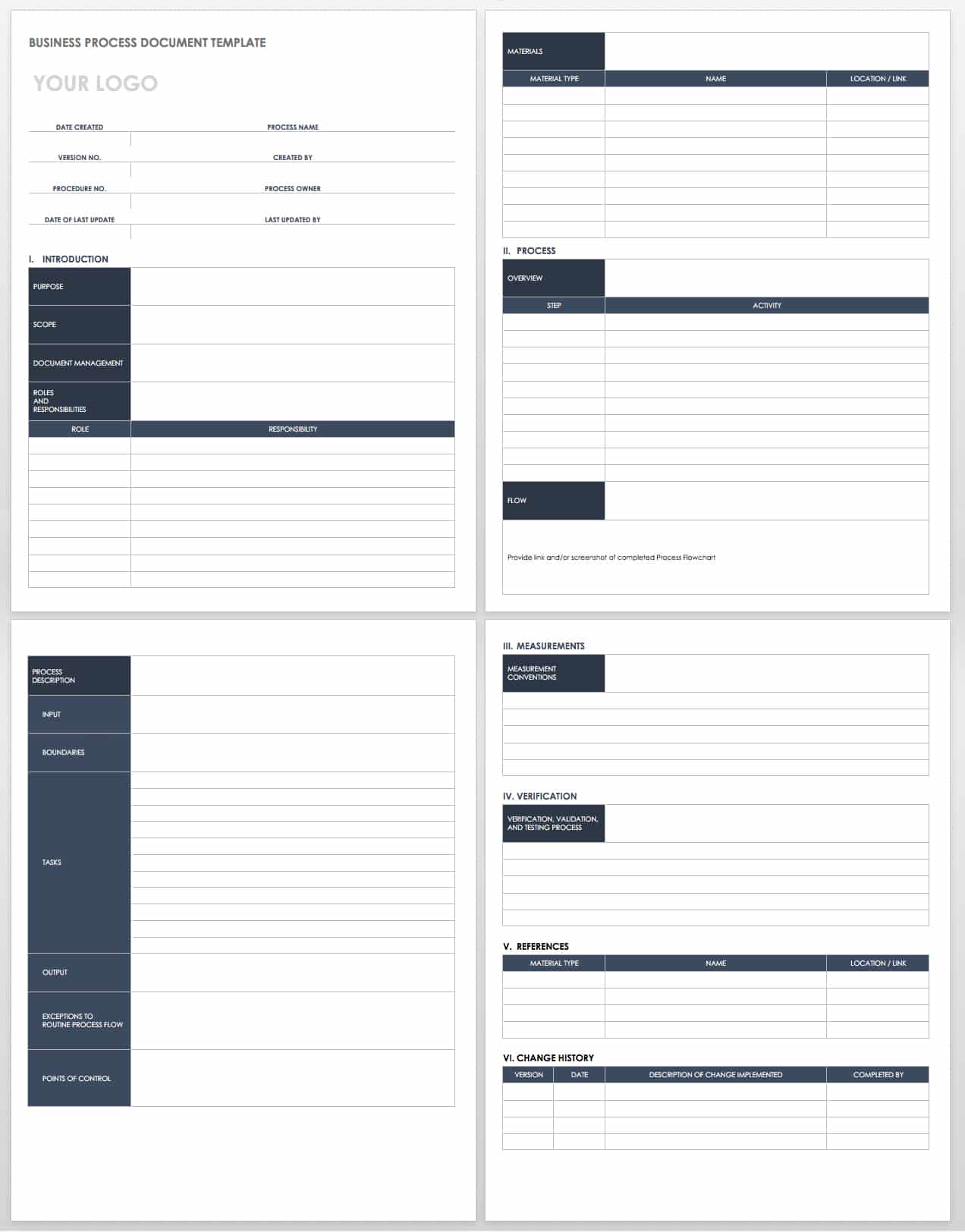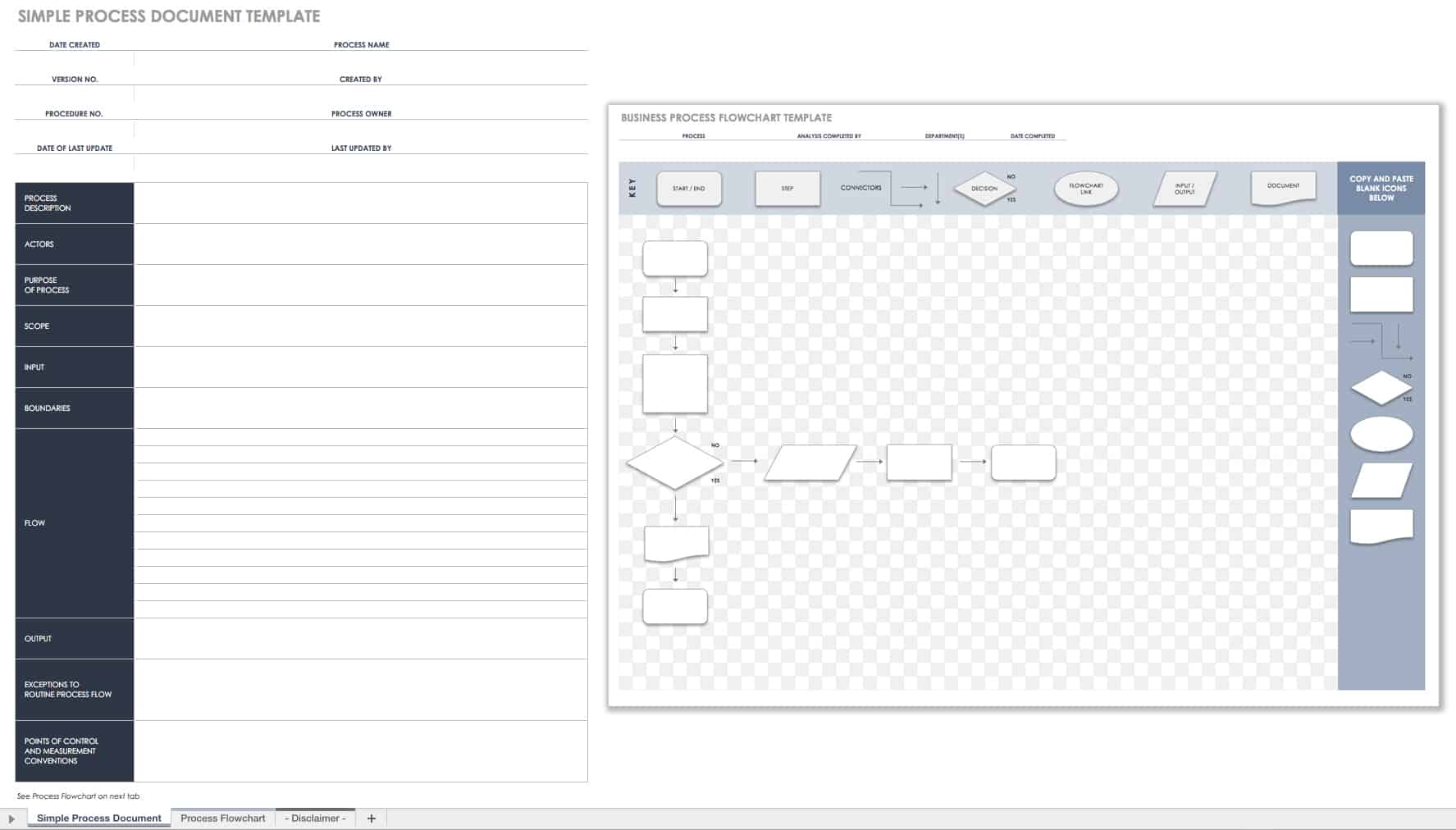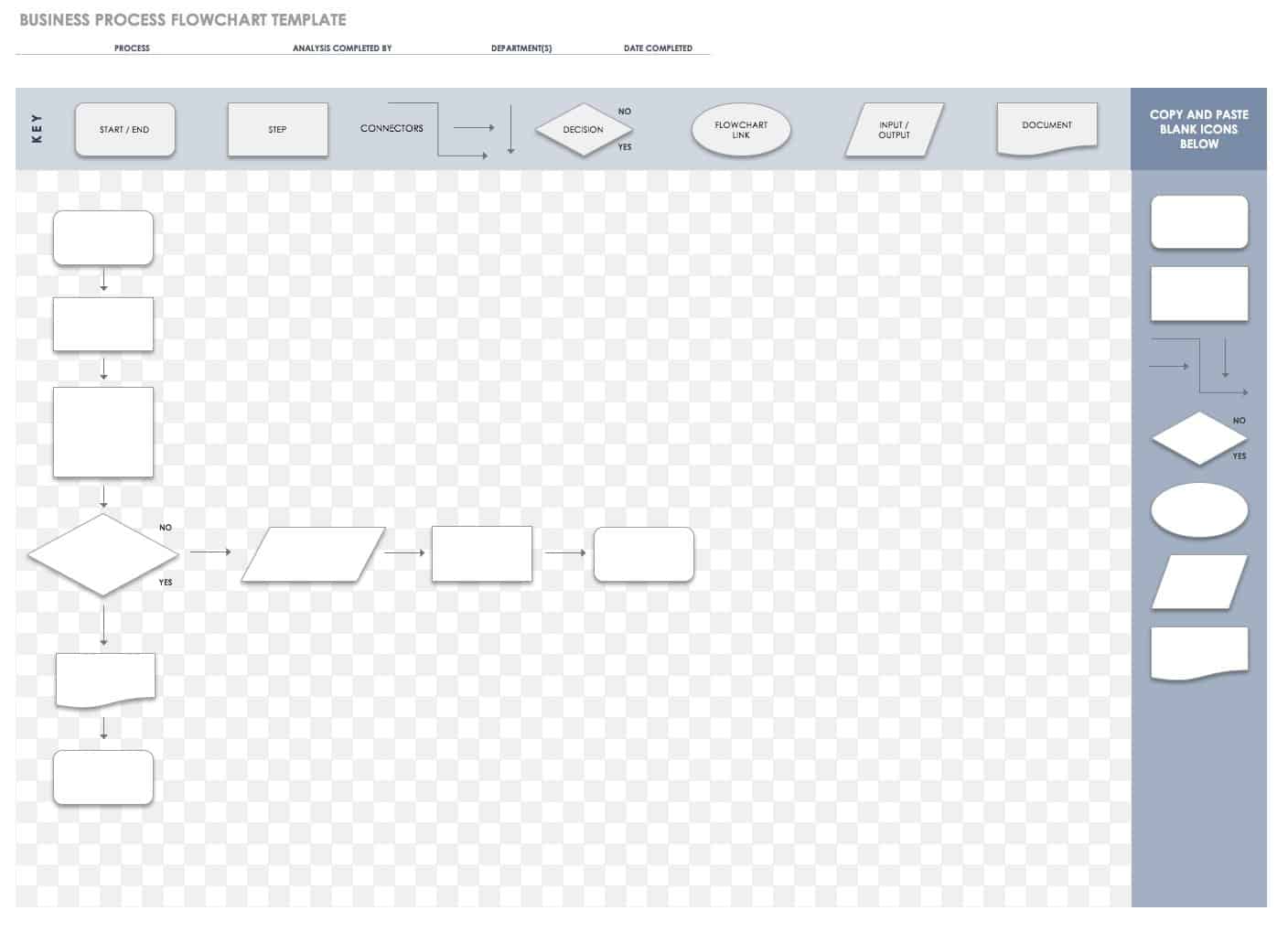Business Process Document Template - Word
Create a formal business process document using this outline for Microsoft Word. The template includes typical sections for documentation — including process purpose, flow, roles, and other details — and can easily be edited to suit your particular needs. Simple formatting makes this template easy to use and share with team members, stakeholders, and other interested parties.
Simple Process Document Template - Excel
This documentation template provides a basic format for entering process details along with a flowchart for visual mapping. Customize the template by editing or adding sections based on your specific business and project. Since this is an Excel template, you can also add new sheets for tracking and analyzing process measurements. Print the template by saving it as a PDF file.
Download Simple Process Document Template - Excel
Business Process Flowchart - Excel
Use this flowchart template for process mapping and add it to your business process document. Flowcharts are often created using Visio or other mapping software, but this simple template provides symbols that you can cut and paste for an easy and cost-effective solution. Create a visual representation of each step in a business process.
Download Business Process Flowchart - Excel
Process Documentation Benefits
Process documentation can affect not only the efficiency of individual processes, but also the overall performance within a business. Here are a few of the potential benefits that can result from accurate documentation:
- Facilitate Transitions: Documentation can provide a close-up look at a given process as well as a larger context for how it fits with other business practices. This information is useful for determining how to integrate multiple processes or to make changes to an individual process. For example, if you’re switching from a manual process to automation, having a process document in place can help ease the transition.
- Improve Communication: Having a process guide encourages mutual understanding across an organization, which supports planning and implementation for new projects or process changes. It can also streamline training for new employees or when outsourcing projects. The documentation process can also spark discussion among stakeholders, potentially leading to innovation and improvement.
- Provide Structure: Defining the boundaries and control points for a process provides clarity about procedures and outcomes to help ensure it is being carried out efficiently.
- Reduce Costs: If you can increase efficiency while improving quality, the result is likely to be a boost to your bottom line and to customer satisfaction.
For all the advantages of process documentation, there can also be some drawbacks. For instance, if a process is recorded incorrectly, the document will be inaccurate and potentially harmful. The person responsible for documentation should have a thorough understanding of the process or be part of a team of stakeholders that can help ensure accuracy. Having clear guidelines for process management procedures can provide structure and accountability for whoever is developing the document. A project may also be slowed down initially as the documentation process takes place, but ultimately it should support efficiency and expedite any changes to a process that might be needed in the future.
Best Practices for Documentation
A clear and concise process document can help manage timely changes and provide a valuable reference guide. To be effective, it needs to be thorough and well-written so that readers can utilize the document. Here are some best practices and tips to keep in mind:
- Watch for possible improvements while going through the documentation process.
- Review documents regularly and revise them as processes change. Keep track of process changes by including a “change history” section in the document.
- Solicit feedback from employees involved in a process to get details on how activities are executed, the importance of different steps, and other relevant insights.
- Include images and flowcharts to illustrate process steps.
- Use a template for process documentation in order to standardize the approach and final document.
- Create separate documents for individual processes rather than grouping them together in a single document.
The above tips apply to documenting business processes. This is different from software documentation, a term that can apply to various stages of software development, from documentation during planning and management to creating user manuals for final products.
What to Include in a Business Process Document
Making a process document can be as simple as following the outline of a template, but you’ll need to customize it to fit the needs of a specific business. Once the template has been fine-tuned, it can serve as a guide for others within an organization to follow. Below are sections commonly included in a process document:
- Process Name: Sum up the process with a descriptive name that distinguishes it from other processes.
- Introduction: This section may include background information, describe the purpose of the process, and explain the process scope. A scope statement can include both what is and is not included in a process. You may also choose to include an applicability matrix for a quick, visual guide to the process scope and roles involved.
- Process Inputs: Identify what input or need triggers the start of the process.
- Process Boundaries: Define clear parameters for where a process begins and ends.
- Process Flow: Use a flowchart or list all of the tasks involved in a process and their organization. Providing a visual illustration of the steps in a process can help readers quickly understand how it flows from start to finish.
- Process Outputs: This may be an actual product or less tangible result, but all processes have a purpose that they are designed to achieve. An output may actually be outside of the defined boundaries of a process, but knowing the expected outcome is relevant to understanding a process.
- Exceptions: Outline the exception management process, which is how exceptions to the normal process flow will be handled when they arise.
- Roles and Responsibilities: Multiple people may be responsible for carrying out different aspects of a business process. Include a list all of the roles and their associated responsibilities so that it’s clear who to contact when a problem occurs or a change needs to be implemented. Some process documents include a decision matrix to illustrate who can make decisions about different elements of a process.
- Process Approval: Outline procedures for reviewing, revising, and approving process documents.
A process document may also include specific measurements for tracking process performance, a reference section for citing other documents, and a change history for recording updates.
Process Documentation for Healthcare Organizations
Healthcare organizations rely on accurate, real-time clinical documentation and process records to make quick, agile decisions, track, analyze, and report on the progress of a patient, clinical study, or other health-related research, and facilitate communication across the organization.
Documentation is also necessary for healthcare providers when evaluating claims and reviewing patient information. Additionally, healthcare companies must abide by stringent security measures, ensuring that all processes, data, and health information are securely stored, tracked, and maintained. To ensure optimal quality of care, foster communication between providers and patients, and maintain confidentiality of data and information, you need a powerful, real-time tool that empowers healthcare organizations to effectively manage documentation.
Smartsheet is a work execution platform that enables healthcare companies to improve work efficiency, scale repetitive processes, and securely store and share protected health information. Track and manage important documents in one centralized location and share reports with authorized team members, while maintaining top-level data security and protection under HIPAA regulatory requirements.
Interested in learning more about how Smartsheet can help you maximize your efforts? Discover Smartsheet for Healthcare.
Improve Process Document Management with Smartsheet
Empower your people to go above and beyond with a flexible platform designed to match the needs of your team — and adapt as those needs change.
The Smartsheet platform makes it easy to plan, capture, manage, and report on work from anywhere, helping your team be more effective and get more done. Report on key metrics and get real-time visibility into work as it happens with roll-up reports, dashboards, and automated workflows built to keep your team connected and informed.
When teams have clarity into the work getting done, there’s no telling how much more they can accomplish in the same amount of time. Try Smartsheet for free, today.



